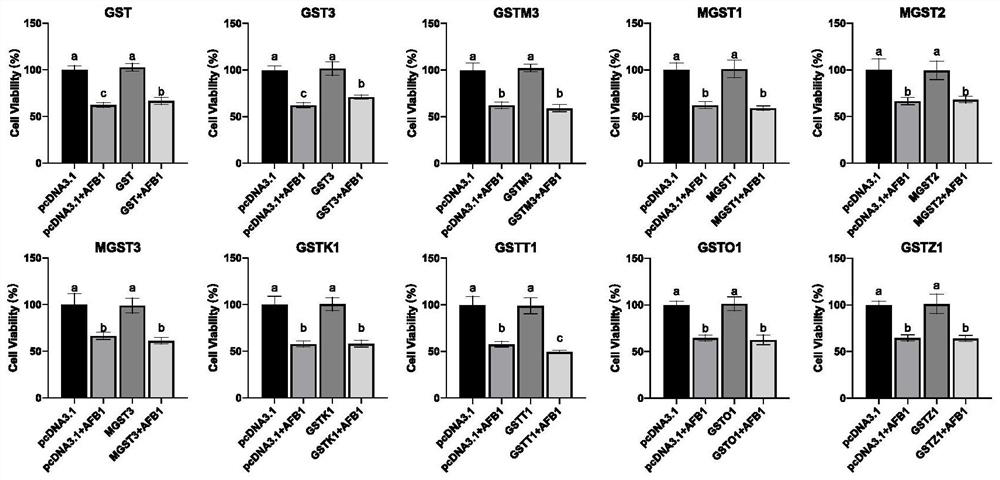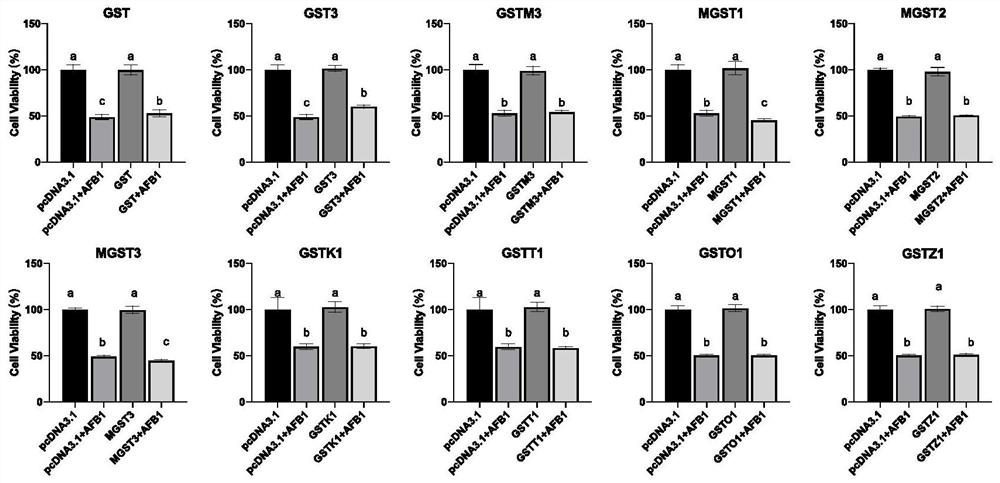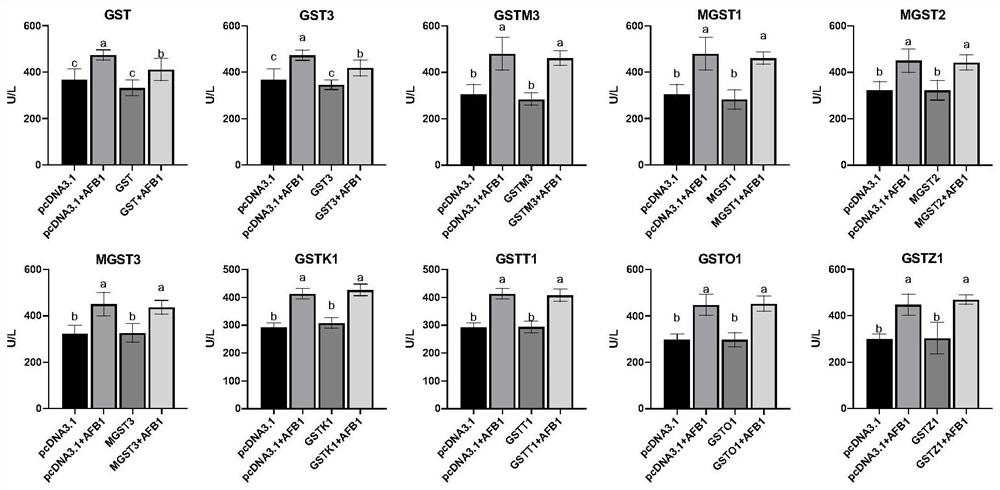Application of glutathione mercaptotransferase as detoxifying enzyme for preventing and treating duck liver injury caused by AFB1
A thiol transferase, glutathione technology, applied in the direction of transferase, application, gene therapy, etc., can solve the problem of unclear liver toxicity
- Summary
- Abstract
- Description
- Claims
- Application Information
AI Technical Summary
Problems solved by technology
Method used
Image
Examples
Embodiment 1
[0033] Example 1 AFB 1 Changes of cell viability in duck primary hepatocytes transfected with empty plasmid and after GSTs overexpressed duck primary hepatocytes
[0034] The CDs fragments of any of the GSTs genes in Table 1 below were cloned from duck liver cDNA to construct pcDNA3.1(+)-GSTs recombinant expression vector and transfected; and the GST transfection efficiency was verified by qPCR. The control group was the pcDNA3.1(+) transfection group of duck primary hepatocytes, and the experimental group was the transfection group with different pcDNA3.1(+)-GSTs; taking GST as an example:
[0035] The GST CDs fragments cloned from duck liver cDNA were recovered by gel and were homologously recombined into pcDNA3.1(+), and the pcDNA3.1(+)-GST recombinant expression vector was obtained after successful sequencing and alignment. Duck primary hepatocytes were isolated from duck liver by in situ perfusion. After 24 hours of adherent culture, the cells were respectively transfect...
Embodiment 2
[0040] Example 2 AFB 1 Changes of LDH activity in cell culture medium of duck primary hepatocytes transfected with empty plasmid and GSTs overexpressed duck primary hepatocytes
[0041] The control group was the duck primary hepatocyte empty plasmid transfection group (pcDNA3.1(+)), and the experimental group was the transfection group with different GSTs. 24h after transfection, two different concentrations of AFB, 75ppb and 150ppb, were selected 1 The culture medium was used for the challenge test. Twenty-four hours after the challenge, the culture medium supernatant in the cell culture dish was taken for LDH (lactate dehydrogenase) detection, and the detection method was carried out in strict accordance with the instructions of Nanjing detection LDH detection kit.
[0042] The result is as image 3 and Figure 4 Shown: AFB at 75ppb and 150ppb 1 The activity of LDH in the cell culture medium was significantly increased under the action of GST3, indicating that the cells...
Embodiment 3
[0043] Example 3: AFB 1 Changes of AFBO-GSH content in duck primary hepatocytes transfected with empty plasmid and in duck primary hepatocytes overexpressing GSTs
[0044] The control group was the duck primary hepatocyte empty plasmid transfection group (pcDNA3.1(+)), and the experimental group was the transfection group with different GSTs. 24h after transfection, with 75ppb of AFB 1 The culture medium was used for the challenge test. After 24 hours of challenge, the cells and culture medium were collected into 2ml centrifuge tubes and frozen at -80°C. The collected samples were freeze-dried, extracted and derivatized, and then the content of AFBO-GSH was detected by liquid chromatography.
[0045] The results of liquid chromatography showed that among the 10 transfected GSTs, only GST and GST3 could significantly increase the content of AFBO detoxification metabolite AFBO-GSH (46% and 13%), indicating that they can significantly alleviate AFB. 1 Toxicity to duck primary...
PUM
 Login to View More
Login to View More Abstract
Description
Claims
Application Information
 Login to View More
Login to View More - R&D
- Intellectual Property
- Life Sciences
- Materials
- Tech Scout
- Unparalleled Data Quality
- Higher Quality Content
- 60% Fewer Hallucinations
Browse by: Latest US Patents, China's latest patents, Technical Efficacy Thesaurus, Application Domain, Technology Topic, Popular Technical Reports.
© 2025 PatSnap. All rights reserved.Legal|Privacy policy|Modern Slavery Act Transparency Statement|Sitemap|About US| Contact US: help@patsnap.com



